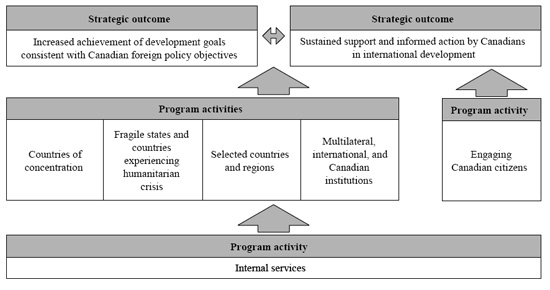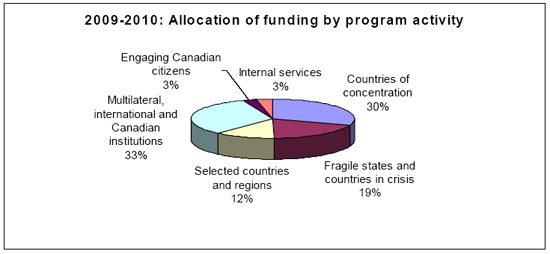Common menu bar links
Breadcrumb Trail
ARCHIVED - Canadian International Development Agency
 This page has been archived.
This page has been archived.
Archived Content
Information identified as archived on the Web is for reference, research or recordkeeping purposes. It has not been altered or updated after the date of archiving. Web pages that are archived on the Web are not subject to the Government of Canada Web Standards. As per the Communications Policy of the Government of Canada, you can request alternate formats on the "Contact Us" page.
Message from the Minister
 The global economic downturn presents significant challenges for all Canadians and for the international community. It is the responsibility of the Canadian International Development Agency (CIDA) to not abandon the world’s most vulnerable, but to dedicate itself to making Canada’s international aid more effective and to ensuring Canada is meeting its international responsibilities.
The global economic downturn presents significant challenges for all Canadians and for the international community. It is the responsibility of the Canadian International Development Agency (CIDA) to not abandon the world’s most vulnerable, but to dedicate itself to making Canada’s international aid more effective and to ensuring Canada is meeting its international responsibilities.
All of CIDA’s efforts are focused on achieving real results and real outcomes. Canada's international aid program is increasingly focused, effective, and accountable. The decision to fully untie aid, including food aid, announced last year is a concrete example of this. In 2009–2010, particular attention will be paid to implementing our effectiveness agenda.
CIDA remains committed to the reconstruction and long-term development of Afghanistan. As part of a whole-of-government effort, the Agency will support Canada’s six strategic priorities. Our efforts in Kandahar province will be supported with a stronger civilian presence on the ground.
Our re-engagement in the Americas will gain momentum in 2009–2010 with focused efforts in democratic governance, regional economic growth, and community stability and security.
Building on Canada’s significant contribution to tackle food insecurity in 2008-2009, Canada will ensure that CIDA continues to support those most in need with a focus on food assistance, agricultural support, and nutrition over the next year.
In the year ahead, we will remain focused on our purpose: to reduce poverty through effective development assistance. Our efforts toward the achievement of development results are outlined in the Agency’s 2009-2010 Report on Plans and Priorities. I am pleased to table this report for Parliament’s consideration.
____________________________________
The Honourable Beverley J. Oda, P.C., M.P.
Minister of International Cooperation
Section 1: Departmental Overview
1.1 Role and responsibilities
The Canadian International Development Agency (CIDA) is the government’s principal organization responsible for delivering humanitarian assistance, and development policy and programming.
As part of the international community Canada recognizes that failure to achieve significant political, economic, social, and environmental progress in the developing world will affect the prosperity and long-term security of Canada. Canada’s development assistance program promotes Canadian values of democracy, freedom, human rights, and the rule of law.
CIDA provides opportunities for Canadians to participate in and learn about international development. This leads to a greater sense of engagement, ownership, and support for Canada’s international development effort.
1.2 Strategic outcomes and Program Activity Architecture
Across all of its activities, CIDA is focused on two strategic outcomes. The first relates to Canada’s contribution to international development goals. Canada, as part of the broader donor community, contributes to the goals of poverty reduction in line with the Millennium Development Goals (MDGs) and democratic governance objectives. Progress across these development goals and others is the result of partnerships with key stakeholders such as recipient countries themselves; multilateral, international, and Canadian institutions; the private sector; non-governmental organizations; and other government departments.
The second strategic outcome relates to ensuring that Canadians play a vital role in international development. Canadians help to make Canada’s development effort stronger through their financial and in-kind support, and their innovative ideas.
These two strategic outcomes are supported by six program activities as illustrated on the next page.

1.3 Planning summary
| Financial resources (planned spending in thousands of dollars) |
Human resources (full-time equivalents) |
|---|---|
| 2009–2010 | 2009–2010 |
| 3,248,388 | 1,905 |
| Strategic outcome 1: Increased achievement of development goals consistent with Canadian foreign policy objectives | ||||
|---|---|---|---|---|
Performance indicators
|
||||
| Program activity | Expected results | Forecast spending 2008-2009 (thousands of dollars) |
Planned spending 2009-2010 (thousands of dollars) |
Alignment to Government of Canada outcomes |
| Countries of concentration | Enhanced capacity of countries of concentration to achieve development goals | 959,368 | 985,814 | Global poverty reduction through sustainable development |
| Fragile states and countries experiencing humanitarian crises | Reduced vulnerability of crisis-affected people Restored capacity of public institutions and civil society |
785,0201 | 625,521 | A safe and secure world |
| Selected countries and regions | Enhanced capacity of selected countries and regions to achieve stability and/or development goals Contribution to international interests of the Government of Canada |
299,141 | 391,185 | Global poverty reduction through sustainable development |
| Multilateral, international, and Canadian institutions | Enhanced capacity and effectiveness of multilateral institutions and Canadian/international organizations in achieving development goals | 1,261,234 | 1,052,142 | Global poverty reduction through sustainable development |
| Strategic outcome 2: Sustained support and informed action by Canadians in international development | ||||
|---|---|---|---|---|
Performance indicators
|
||||
| Program activity | Expected results | Forecast spending 2008-2009 (thousands of dollars) |
Planned spending 2009-2010 (thousands of dollars) |
Alignment to Government of Canada outcomes |
| Engaging Canadian citizens | Increased awareness, deepened understanding, and greater engagement of Canadians with respect to international development issues | 61,755 | 80,1652 | Global poverty reduction through sustainable development |
| In support of both strategic outcomes | ||||
|---|---|---|---|---|
| Program activity | Expected results | Forecast spending 2008-2009 (thousands of dollars) |
Planned spending 2009-2010 (thousands of dollars) |
Alignment to Government of Canada outcomes |
| Internal services | Provides support services to CIDA programming | 117,290 | 113,561 | Global poverty reduction through sustainable development |
CIDA’s operating environment
From its earliest days, Canada’s development assistance has targeted poor and marginalized countries. Over the years, Canada’s approach to international development has moved in step with major international reforms in development practice. CIDA’s approach strives to reflect lessons learned and new approaches to development cooperation, as well as take into consideration key international, domestic, and internal factors that influence the context in which the Agency operates, as outlined below. CIDA’s agenda over the last year has centered on increasing results by strengthening program focus, effectiveness, and accountability for results.
International development context
A number of factors will influence Canada’s development agenda in the coming years. These include the changing dynamics in countries and regions where CIDA programs, the global economic downturn and its impact on financial flows to developing countries, evolving and increasing challenges regarding security issues where humanitarian workers are targeted and access to humanitarian organizations is being denied, the effect of erratic commodity fluctuations on developing countries (e.g. food, fuel), uncertainties in the multilateral trading system, climate change, food insecurity, health pandemics, and population growth.
The United Nations conducted a midpoint assessment of the MDGs3 in 2008. This assessment pointed to a number of recent successes across the developing world, including improved macroeconomic indicators, expansion of AIDS treatment, increased agricultural productivity and school enrolment, and access to water and sanitation. However, large disparities persist among, and within, countries. Progress on achieving gender equality and women’s empowerment, for example, is mixed. While it is recognized that not all regions will meet every MDG, according to the UN, based on current trends, no sub-Saharan African country is likely to achieve all the MDGs. Countries emerging from conflict or facing political instability face particular challenges. In middle-income countries, even where progress is most rapid, large pockets of inequality mean that millions of people continue to live in extreme poverty.
Also of note is the Government’s and the international community’s continued focus on making aid flows more effective. The development community gathered in Accra, Ghana, in September 2008 to review progress against the commitments and targets of the 2005 Paris Declaration on Aid Effectiveness, and renew its resolve to improve the management of aid. The Accra Agenda for Action called for efforts on aid effectiveness to be intensified.
Domestic environment
In its 2007 and 2008 Speeches from the Throne and Budgets, the Government of Canada committed to improving the effectiveness of Canadian aid, and reinforced its commitments to Afghanistan, Africa, Haiti, and the Americas.
As part of its aid effectiveness agenda, Canada has initiated a number of measures to reform its aid program. For example, in April 2008, the government announced its decision to untie 100 percent of food aid, followed in September with its decision to untie all of its development aid by 2012–2013. CIDA also released in November 2008 Canada’s International Assistance at Work: Development for Results, its first report to Canadians focused on development results. In February 2009, CIDA announced 20 countries of focus for its bilateral program.
The Official Development Assistance Accountability Act, enacted June 2008, has implications for how CIDA will develop, manage, and report on its programs. More specifically, the act seeks to ensure that all Canadian official development assistance contributes to poverty reduction, takes into account the perspectives of the poor, and is consistent with international human rights standards.
The Federal Accountability Act also continues to strengthen the planning, delivery, and results of Canada’s development assistance program, and has resulted in the creation of an independent audit function, strengthened evaluations, and a greater emphasis on results.
Risk analysis
As noted by the Auditor General, the World Bank, and many others, development is inherently risky. Consequently, a thorough assessment of the spectrum of risks is integral to CIDA’s work. The Agency makes responsible investments in monitoring, evaluations, and audits to ensure that identified and emerging risks are adequately mitigated. Risks are further mitigated through the implementation of the Fiduciary Risk Assessment Policy, which relates to the use of countries’ and multilateral organizations’ financial systems.
CIDA groups its risks under four categories: operational risks, financial risks, developmental risks, and reputational risks. The Agency continually assesses the likelihood and impact of risks, and develops mitigation strategies. These strategies are focused on addressing risks that would affect the Agency’s ability to fully implement the government’s strategic direction, and to enhance CIDA’s reputation by demonstrating tangible results.
Description of CIDA’s priorities
CIDA’s priorities are grouped as, first, those responding to key priorities of the Government of Canada, to key risks, and to the evolving international context; and, secondly, those related to the management of the Agency. Each of these priorities contributes to the two CIDA strategic outcomes depicted in section 1.2.
| Operational priority | Type |
|---|---|
| Strengthen the effectiveness of Canada’s aid program and implement the Paris Declaration on Aid Effectiveness | Ongoing |
| Canada’s strategic role in Afghanistan and other fragile states | Ongoing |
| Support the government’s commitment to the Americas | Ongoing |
| Contribute to mitigating the food security crisis | New |
| Management priority | Type |
| Implement CIDA’s Public Service Renewal action plan | Ongoing |
Strengthen the effectiveness of Canada’s aid program and implement the Paris Declaration on Aid Effectiveness
Canada has already initiated a number of measures to improve the focus, efficiency, and accountability of its aid program. It will continue efforts aimed at increasing geographic concentration, enhancing its field presence, untying aid, reducing administrative expenses, strengthening independent evaluations, and improving reporting and communications. These initiatives provide a solid basis for accelerating progress on Canada’s international commitments to improve aid effectiveness.
(Canadian statement, Accra High Level Forum 2008)
This Canadian agenda will enhance Canada’s prospect of meeting important targets as defined in the 2005 Paris Declaration on Aid Effectiveness and the 2008 Accra Agenda for Action4. In particular, it will lead to:
- increased impact and realization of results benefitting those most in need;
- increased the transparency and accountability of aid commitments and disbursements;
- strengthened developing-country capacity and systems to enable countries’ ability to deliver basic services to their population; and
- more strategic efforts to engage with civil society organizations.
Canada’s strategic role in Afghanistan and other fragile states
The security, humanitarian assistance, and development needs of fragile states is rising in importance for all donors. Through CIDA’s involvement in countries such as Afghanistan, the Agency will apply its effectiveness agenda to strengthen Canada’s role in the reconstruction and development in fragile states. A balance between short- and long-term interventions will help enable actions that support stability, good governance, and progress for sustainable development over the longer term.
Aligned with Canada’s whole-of-government approach, CIDA will deliver development assistance in partnership with other government departments to advance Canada’s mission in Afghanistan. CIDA’s engagement in fragile states will remain a significant part of Canada’s efforts in Africa.
Support the government’s commitment to the Americas
CIDA will continue to play a key role in advancing elements of the government’s Americas Strategy. CIDA is aligning its programming to support the three themes of the government’s engagement: democratic governance, prosperity, and security.
The Agency’s objective in democratic governance is to strengthen the capacity of political institutions and public administration systems in support of freedom and democracy, human rights, the rule of law, and accountable public institutions. Under prosperity, the Agency will support regional economic growth and enhance the ability of disadvantaged women, men, and youth to participate in, contribute to, and benefit from better economies. In contributing to security, CIDA’s objective is to build safer communities and a stable local environment for business and investment. Country and regional programming will focus on building resilience to natural disasters (including food security), health pandemics, as well as crime.
Haiti figures prominently in Canada’s renewed engagement with the Americas. CIDA will play the major role in the whole-of-government effort central to Canada’s support to Haiti.
Contribute to mitigating the food security crisis
The world food situation has been challenged by the dramatic volatility in the price of food, and the impact of natural disasters on the agricultural sector. This has translated into mounting global food insecurity, and a decreased ability to meet food and nutritional requirements, particularly among vulnerable populations.
In recognition of these realities, CIDA is reviewing its programming as it relates to food security. This review will lead to a new food security strategy focused on meeting today’s challenges, ensuring long-term food security of poor and vulnerable people in developing countries, and spurring agricultural productivity as an engine of economic growth. The scope of this effort will include activities related to food assistance, agriculture, nutrition, and research and innovation.
Implement CIDA’s Public Service Renewal action plan
Public service renewal is a priority of the Government of Canada. It is focused on ensuring that the federal public service continues to be a modern, accountable, world-class institution that is dynamic and representative, and strives for excellence. The Clerk of the Privy Council’s action plan has four priority areas: planning, recruitment, employee development, and enabling infrastructure. In response to the Clerk’s action plan, CIDA will implement a multiyear plan in which “Excellence in People Management” is the cornerstone. CIDA will also build an overarching integrated planning and reporting framework to facilitate the achievement of CIDA’s strategic direction, improve the information available for decision making, strengthen accountability, and allow CIDA to better demonstrate value-for-money to Canadians.
1.4 Expenditure profile
CIDA plans to spend $3.2245 billion in 2009–2010 to undertake its program activities and contribute to its strategic outcomes. The figure below displays the allocation of CIDA’s funding by program activity.

Voted and statutory items
| Voted or statutory item | Truncated vote or statutory wording | 2008-2009 Main Estimates ($ thousands) |
2009-2010 Main Estimates ($ thousands) |
|---|---|---|---|
| 25 | Operating expenditures | 224,674 | 203,668 |
| 30 | Grants and contributions | 2,553,452 | 2,608,225 |
| (S) | Minister of International Cooperation – Salary and motor car allowance |
76 | 78 |
| (S) |
Encashment of notes issued to the development assistance funds of the international financial institutions in accordance with the International Development (Financial Institutions) Assistance Act |
257,861 | 231,336 |
| (S) | Contributions to employee benefit plans | 25,784 | 25,955 |
| Total budgetary |
3,061,847 |
3,069,262 | |
| L35 | The issuance and payment of notes to the International Financial Institution Fund Accounts | - | - |
| (S) | Payments to international financial institutions -- Capital subscriptions |
8,004 |
- |
| Total non-budgetary | 8,004 | - | |
| Total Agency | 3,069,851 | 3,069,262 |
1 This figure reflects a higher level of spending than initially forecast due to, among other things, emergency responses to Cyclone Nargis in Burma and the earthquake in China, and increased food aid to respond to the crisis that emerged.
2 This figure reflects a realignment of programming between program activities.
3 For more information on the MDGs, visit http://www.undp.org/mdg.
4 For more information and full texts of the Paris Declaration on Aid Effectiveness and Accra Agenda for Action, see http://www.accrahlf.net/.
5 Includes Main Estimates and Supplementary Estimates A figures.
